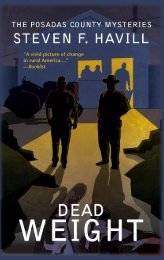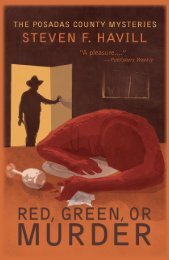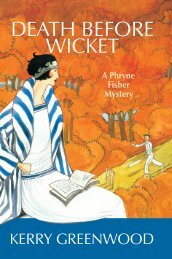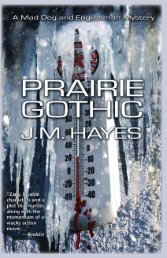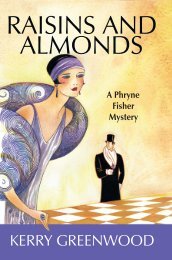The Heirs of Anthony Boucher Marvin Lachman
The Heirs of Anthony Boucher Marvin Lachman
The Heirs of Anthony Boucher Marvin Lachman
Create successful ePaper yourself
Turn your PDF publications into a flip-book with our unique Google optimized e-Paper software.
Aspects <strong>of</strong> Mystery Fandom<br />
With old-time radio expert Martin Grams, Jr.., Nevins brought it up to date in 2002.<br />
Another successful Nevins bibliographic project was reprinting <strong>Anthony</strong> <strong>Boucher</strong>’s<br />
1940s reviews from the San Francisco Chronicle.<br />
Annotated bibliographies have increasingly taken the form <strong>of</strong> “Companions,”<br />
books that also treat an author’s work in considerable depth and provide biographical<br />
material. Perhaps the earliest was <strong>The</strong> Agatha Christie Companion (1984), which<br />
authors Dennis Sanders and Len Lovallo called a “four-year labor <strong>of</strong> love.” Sometimes<br />
the emphasis is on the author’s character, as in <strong>The</strong> Cadfael Companion (1991)<br />
by Robin Whiteman, about Ellis Peters’ Brother Cadfael. A major part <strong>of</strong> <strong>The</strong> Tony<br />
Hillerman Companion (1994), edited by Martin Greenberg, is a 200-page “concordance”<br />
<strong>of</strong> all the characters in Hillerman’s fiction by Elizabeth A. Gaines and Diane<br />
Hammer.<br />
Another example is Sharon A. Feaster’s <strong>The</strong> Cat Who… Companion (1998) devoted<br />
to the cat mysteries <strong>of</strong> Lilian Jackson Braun. It includes an interview with Braun,<br />
plot summaries <strong>of</strong> her books, an alphabetical list <strong>of</strong> characters in the series, and<br />
even a map <strong>of</strong> its setting, fictional Moose County. <strong>The</strong> format <strong>of</strong> <strong>The</strong> Dick Francis<br />
Companion (2003) by Jean Swanson and Dean James is similar to Feaster’s, but they<br />
added some features appropriate to a guide to Dick Francis: a gazetteer to the racing<br />
locations mentioned, a list <strong>of</strong> the horses in the books, and, fittingly for an author who<br />
so <strong>of</strong>ten grabbed readers with his first sentence, a list <strong>of</strong> memorable opening lines in<br />
the Francis canon.<br />
While the Cold War was still hot, Andy East published <strong>The</strong> Cold War File (1983),<br />
a listing <strong>of</strong> the work <strong>of</strong> eighty authors <strong>of</strong> spy novels. His range was great, from the<br />
literary espionage novels <strong>of</strong> John Le Carré to such sexy novels <strong>of</strong> Ted Mark as <strong>The</strong><br />
Man from O.R.G.Y.<br />
One <strong>of</strong> the most ambitious <strong>of</strong> all fan-bibliographers was Michael L. Cook <strong>of</strong> Evansville,<br />
Indiana. His first “project” was Murder by Mail: Inside the Mystery Book Clubs<br />
(1979) with histories and complete lists <strong>of</strong> <strong>of</strong>ferings <strong>of</strong> the Detective Book Club, the<br />
Mystery Guild and the Unicorn Mystery Book Club. A revision in 1983 updated the<br />
<strong>of</strong>ferings <strong>of</strong> the first two clubs, still active, and added several lesser-known clubs.<br />
<strong>The</strong> long title <strong>of</strong> Cook’s Monthly Murders: A Checklist and Chronological Listing <strong>of</strong><br />
Fiction in the Digest-Size Mystery Magazines in the United States and England (1982)<br />
aptly describes his bibliography <strong>of</strong> about one hundred periodicals. For the computer<br />
age, William G. Contento updated this work in the CD-ROM Mystery Short Fiction<br />
Miscellany: An Index (2003), adding to it information from his Crime and Mystery<br />
Anthologies, compiled with Martin H. Greenberg, first published as a book in 1990.<br />
Two somewhat-related 1983 bibliographies <strong>of</strong> Cook’s were Mystery, Detective, and<br />
Espionage Magazines and Mystery Fanfare: A Composite Annotated Index to Mystery<br />
and Related Fanzines 1 63–1 1. <strong>The</strong> first book included descriptions <strong>of</strong> fan magazines,<br />
along with hundreds <strong>of</strong> pulp and digest-sized fiction magazines. <strong>The</strong> second<br />
book covers almost fifty fan magazines.<br />
Arguably, Cook’s most daunting indexing project, one undertaken with Stephen<br />
T. Miller, was Mystery, Detective, and Espionage Fiction: A Checklist <strong>of</strong> Fiction in US<br />
Pulp Magazines, 1 15–1 4, published in two volumes in 1988. Cook died June 14,<br />
1988, at age fifty-eight, shortly before it was published. <strong>The</strong> first volume is a chrono-<br />
164




